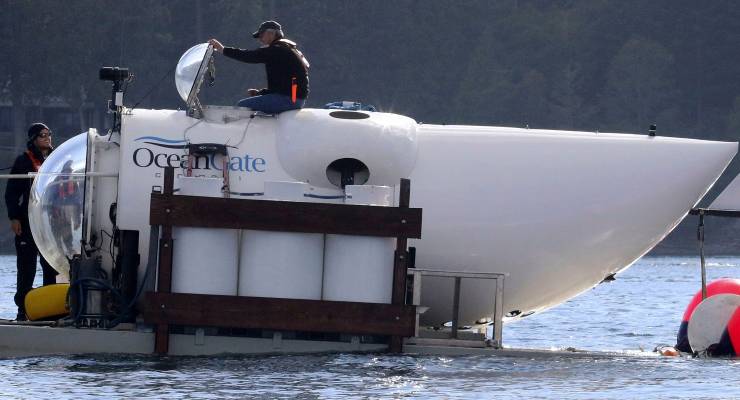
The US Coast Guard announced Thursday that debris found on the seafloor was identified as belonging to the Titan, the OceanGate submersible that had disappeared on June 18. Teams from different countries — including the United States, Canada, the United Kingdom and Germany — were conducting search missions under a very tight timeline.
The discovery, close to the site of the Titanic, indicates the end of search-and-rescue operations for the five people on board, who were killed in a “catastrophic implosion“, according to the Coast Guard.
As one of the largest international marine search-and-rescue operations, the incident raised questions about risk management, search-and-rescue operations, costs and ethical aspects of responses.
Ocean incidents
A significant number of economic activities — including shipping, fishing and offshore oil and gas drilling — are conducted in marine environments. These activities can lead to occurrences of accidents and casualties of different types.
Annually, a large number of incidents happen in the Canadian marine environment. Between 2011 and 2020, 284 occurrences were reported each year that had an annual average of 15.6 fatalities during the same period.
These numbers suggest that relative to the huge number of marine activities and the number of incidents, conventional marine-based operations are relatively safe and the emergency responses to them are effective.
An unusual situation
The search-and-rescue operations for the Titan have been proven to be unusual, as measured by the complexity, costs, time sensitivity and scale. Unlike search-and-rescue operations on the ground that can be undertaken by volunteers and with little or no equipment, marine search and rescue is a highly specialised operation.
It requires high-tech equipment, tools, training, coordination and capacity. In the current case, the search area was not measured in square kilometres or miles — rather, it was in cubic measurements (3D), because the vessel could have been anywhere around the surface, in shallow or deep waters, or on the ocean floor.
While there are capable teams with the needed equipment and training for most marine disasters, they are not sufficient to cover a large area with limited information or uncertainty about the situation.
Operational outcomes
This search operation was among the costliest in recent history. We need to wait to see how much of this cost will be covered by insurance, OceanGate or the public.
This event will generate significant discussions around the public burden of private risks and risk-taking behaviours, and how risks in certain areas are regulated. And it could count for about one-third of Canada’s annual average marine fatalities if it’s considered a Canadian incident.
Particularly, it will bring to the forefront questions about balancing acceptable risks with available emergency response capacities, including search and rescue.
Risk assessments
When embarking on risky operations, such as deep-sea touristic exploration, two elements need to be added to risk assessments: 1) Do we have adequate and timely internal and external capacity to handle a potential incident?; and 2) What are the total response costs of an incident?
While certain risky activities or operations may be acceptable based on a private assessment of risk, they may not be acceptable if we ponder these two aspects.
Unfortunately, many conventional risk assessments, particularly in private sector organisations, do not pay sufficient attention to available emergency response capacities.
When considering the Titan’s search-and-rescue operation, it became clear this small emergency surpassed the capacity of the resources that were operating in the area.
Teams from other places and countries joined the effort, but it took several days for a unified command centre for search and rescue to take shape.
Conducting a survey of available emergency response capacities to risk assessments can make a significant difference in risk management and regulation.
Similarly, many current risk assessments do not fully include emergency response costs in their calculations. While it is not a major consideration for many regular daily activities and operations because the emergency response is within regular possibilities, certain operations — particularly in remote marine environments — ought to add these costs into their risk assessment.
In doing so, risks may become more or less acceptable in terms of mitigation policies and regulations. Incorporating these aspects into risk assessments and regulations could help ensure that private operators provide additional safety and risk mitigation measures and assume responsibility for incurred costs.
This was republished from The Conversation.








Fair enough summary of the issues. It would be a big step in the right direction if there were properly enforced mandatory requirements for full insurance to cover the cost of any foreseeable rescue operation. An insurer would of course only be in a position to offer cover after making a realistic risk assessment, so that aspect would be addressed. If the cost of the required cover was prohibitive, well, good. No such proposed jaunt should go ahead when the risk makes it uninsurable. If that’s not acceptable to the very rich there could be an option to go ahead on the explicit formal understanding that if anything goes wrong there will be no rescue or recovery operation beyond anything they arrange, and pay for directly, themselves.
True SSR.
But I think this operation was flying beneath the radar, so to speak.
firstly ANY marine or aviation operation that carries paying passengers is usually strongly regulated by law.
Ships and boats are covered by Maritime Law which requires inspection of the vessels concerned. This is done by Classification Societies in both the design stages and during operation of the vessel. In addition National bodies such as the Australian Maritime Safety Authority (AMSA) or, in the case of smaller Coastal Vessels by equivalent State (Regional) authorities. State authority being more relaxed than National, usually.
Class inspections (Surveys) are undertaken on a regular schedule. AMSA inspections are undertaken on a random schedule or on suspicion or complaint.
This submarine vessel should not have been carrying passengers if it had not been accepted by a Class Society, then the local version of A.M.S.A.
Without Class approval Maritime Insurance would be either VERY expensive or impossible to obtain.
A quick glance at published specification and materials makes me doubt that the sub. would have received official approval.
As to costs involved I am usually skeptical. The assets and manning are already being paid to keep the rescue craft and crew trained and ready. Additional costs would be, Fuel and provisions plus any extra crew/specialists involved.
Like fighting a bushfire, the Fire Brigades already exist as does the equipment. going to the fire only adds operating costs for the length of the operation. But I guess “Economists” and accountants take into account of asset costs over its lifespan Etc.Etc. Also i guess if the Military is involved they add the daily salaries of the personnel involved. But these are being payed anyway.
As a bonus, the people involved in this SAR are gaining invaluable expertise.
Saving life is usually considered a natural Human response and should not be a topic for beancounters or Media, I believe.
Yes, I am very familar with the work of classification societies and all the engineering bodies and safety regulatory agencies you mention. There is an article in Slate magazine ‘Why the Missing Submarine Didn’t Need to Pass a Federal Safety Check’ that includes:
Exploiting a gap between regulatory regimes and taking full advantage of the resulting lack of oversight, often with severe consequences for other parties, is quite a feature of our times, though I suppose there have always been examples. The ‘social’ media that insist they are not publishers and so not responsible for the content they disseminate; the ‘afterpay’ companies that insist they are not providing credit; the cryptocurrencies that insist they are not trading in anything like securities and so on currently subject to regulation; and so on. Perhaps our governments should be a little less insouciant about it all.
Well, yes, who knows how much better run the next rescue & recovery of a lost very deep-sea submersible will be after this. Maybe ‘bonus’ is putting it rather strongly. Maybe it’s more like it’s not a complete unmitigated loss in every way. And we should, I suppose, be thankful that the rescue & recovery operation itself has not (yet) killed or injured anyone. You make a reasonable point about the cost of deploying existing resources for rescue & recovery is in effect a marginal cost, but of course that would be taken into account in calculating the appropriate insurance premium.
True again SSR. Thanks
Cannot feed or house the poor but millions to search some idiot.
We really need to get our priorities straight.
There are plenty of refugees that need to be rescued at sea.
Alongside articles about the disappearance and sinking of the Titan on the BBC news app today, was an article about at least 30 migrants feared dead after their boat sank off the Canary Islands.
Only difference one was was full of rich people I will let you guess which one.
Rub-a-dub-dub 5 rich men in a sub.
Yes, but you must understand that there are billionaires, and then there are untermenschen. Some people are worth more than others, both in terms of rescue costs and in terms of media coverage.
The loss of a couple of these people is most unfortunate. One of them is part of RMS Titanic, the ghoulish grave robbers and plunderers who have even cut off bits of the wreck. Another is apparently a dodgy customer who has carefully crafted a business which deliberately avoided tests and regulations. I was listening to a former Titanic dive skipper this morning and he was pretty angry about the way the sub was built. PErhpas the ghosts of the Titanic dead have finally risen up at the desecration of their resting place.
The same considerations apply to tourist space expeditions which may turn tricky or falter. It’s only a matter of time.
Just like with Mt Everest climbers it’s amazing the risks well to do people take just for bragging rights. They could have gone to Aegean Sea and visited Titanic’s sister ship the Britannic which sank in 1916 and is only 120 meters under the surface or climb any apex mountain peak in thousands of safer mountain ranges which also look like the top of the world.
Or they could have spent those eye-watering amounts of money on doing something useful – God knows there is no shortage of needy causes in this world.